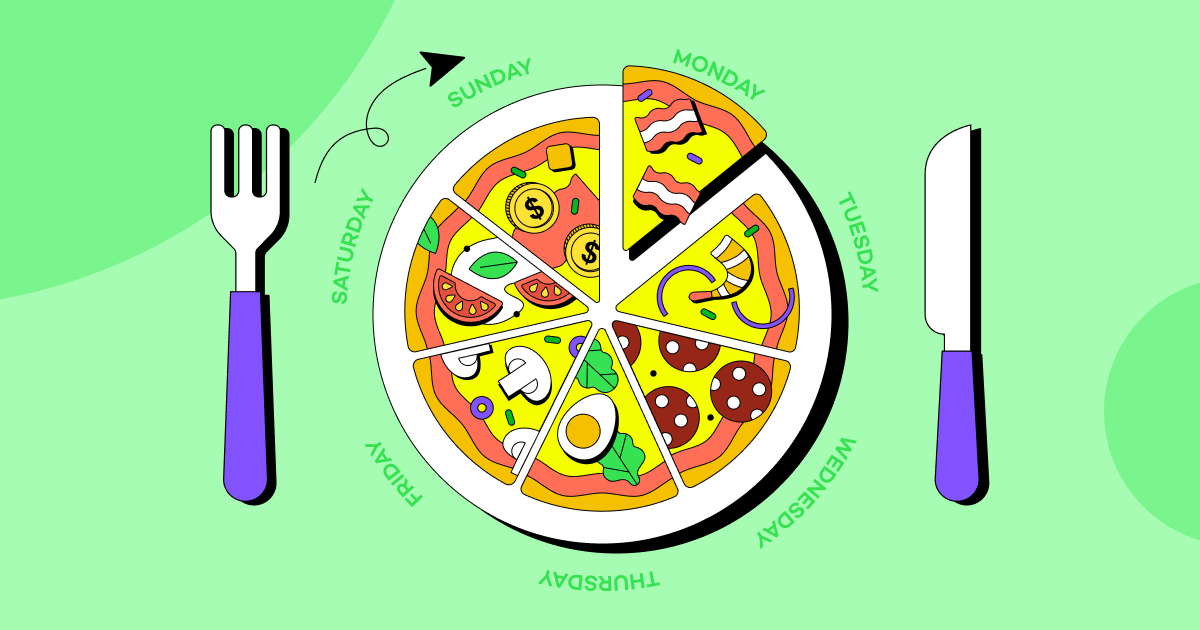Did you know that meal planning can save you hundreds of dollars every month? Planning your meals for the next week may take a bit of time, but it’s so worth it. Besides saving you money, it’ll boost your nutrition and reduce food waste. It’s a win-win-win!
If this sounds like you’ll have to do something extreme, believe us, you won’t. In fact, many people don’t even consider it just because they think it’s too complicated and time-consuming. Actually, it’s the opposite. Knowing exactly what your next meal is will help you avoid the back and forth of deciding what to eat or wasting time on trips to the grocery store every time you miss an ingredient.
And for those who think it’s complicated, we have a simple guide to meal planning to save money and improve your eating habits. Believe us; your wallet will thank you and your health too!
Guide to Meal Planning to Save Money
Whether you are a busy parent, a college student on a budget, or just someone who wants to make smarter food choices, these tips will help you get started with meal planning and make it a regular part of your routine. So, let’s dive in and learn how to meal plan like a pro!
1. Give Yourself Time to Plan before You Start the Week
If you’re new to meal planning, you may need around 30 minutes to plan your meals for the upcoming week. With time, you’ll probably do this a lot faster, but for now, make sure you give yourself half an hour once a week.
Grab a piece of paper and go to the kitchen. And when we say the kitchen, we really mean it. It’s the best place for this job as you can see what you have on hand and what you’re missing while making the plan. And don’t rely on memory to avoid ending up with more cereal boxes and fewer eggs than you need.
2. Check Your Calendar
Taking a few minutes to check your calendar when making a meal plan can help you plan more efficiently, reduce stress, and ensure your meals fit your lifestyle. So take note of any events, appointments, or activities you’ve planned for the week that may affect your meal planning.
For example, if you have a late meeting on Tuesday night, plan for a quick and easy dinner that day. Or if you’re expecting a crowd on Wednesday, you may need to double the recipe to feed everyone. Don’t worry if there are any leftovers. You can always freeze them and use them in the evenings when you don’t have time to cook.
3. Check Your Fridge, Pantry, and Freezer
By taking inventory of what you already have, you can plan meals that use ingredients that may otherwise go to waste. Besides reducing food waste, this can also save you money as you won’t have to purchase ingredients you already have.
At the same time, it may also help you get creative with your meals. Using up the ingredients you have in your kitchen may inspire you to try new recipes or use different combinations of ingredients to make a unique and delicious meal.
4. Watch Sales
Watching sales when making a meal plan is a smart way to save money on groceries. Many grocery stores offer weekly or monthly sales on certain items, so by keeping an eye out for student discounts on food, you can plan your meals around the discounted items.
This can help you save money on your grocery bill while still allowing you to plan nutritious and satisfying meals. Additionally, taking advantage of sales can help you stock up on pantry staples or freezer-friendly items that can be used in future meals. You can also consider comparing prices between different stores and searching for coupons.
5. Eat Seasonally
Seasonal, locally sourced produce is a better option than out-of-season imported goods for a few reasons. For starters, it’s cheaper. That’s because when produce is in season, it’s often more abundant and, therefore, less expensive. This is why you should plan your meals around seasonal produce to save money on your grocery bill.
In addition, seasonal produce is typically fresher and has more flavor than out-of-season produce. The reason is that it’s grown locally and picked at the peak of its ripeness, so it doesn’t have to travel as far to reach your grocery store. Plus, you can freeze it or can it for later use.
6. Find Recipes
Looking for recipes can help you add variety to your meal plan. Instead of repeating the same meals over and over, you can try new recipes and experiment with different flavors and ingredients. This can also help you to save time and money as you’ll already know exactly what ingredients you need when going to the supermarket or grocery store.
Trying to find recipes that include ingredients you already have or produce that’ll soon expire can cut down on your spending. After all, you’re meal planning to save money, so consider everything you already have at home.
7. Jot Down Meal Ideas
Writing down your meal plan for the next week or month will help you stick to it and avoid spending money on things that aren’t on the list. But even if you already have your meal plan prepared, you can always jot down interesting ideas you hear or see throughout the day.
This way, you can have new breakfast, lunch, or dinner ideas for the coming week. It’s a great way to add variety to your meal plan and keep you from getting bored.
8. Go Shopping
Once you have your grocery list, it’s time to go shopping. Make sure you take it with you and buy only the things on it because groceries can easily be overbought. Of course, you can buy anything else if you realize you’ve forgotten to put it on your list and you really need it.
The goal is to avoid wasting time on random junk you don’t even need. You can also consider ordering groceries online if you don’t have time to go to the store. This way, you can avoid being tempted by the eye-catching displays with snacks and things you don’t want to eat.
9. Buy Generic
Many generic brands offer the same quality and taste as branded products, and some may even be made by the same manufacturers. But most importantly, they are usually less expensive than their branded counterparts.
So the next time you shop, try the boring label to avoid paying extra money for attractive logo designs.
10. Consider Your Budget
By setting a budget for your groceries and meal planning accordingly, you can ensure you are not overspending on food. It’s best to do this at the beginning of each meal planning cycle. For example, if your family spends $1000 a month, the weekly budget is around $250. So when planning your meals, try to stay under this amount.
And if you think your family is spending too much on groceries and meals, you can set a new weekly or monthly budget. Whenever you exceed the limit, buy fewer things for the next week to balance out and stay within the budget. Check our blog on how to eat healthy on a budget if you struggle with this.
11. Eat the Same Breakfast
Eating a different thing for breakfast every day means spending more money on different ingredients. While variety can help you stick to meal planning to save money, it can also hurt your budget if you overdo it.
Therefore, try to find a meal you can eat for breakfast every day or every other day. This will help you take advantage of sales and buy in bulk. For example, if you decide on Greek yogurt with peanut butter and granola, you can find larger containers of Greek yogurt and peanut butter for lower prices. This way, you can have a healthy breakfast every day for a dollar or two.
12. Limit Your Snacks
Snacks keep us full till the next meal, so don’t avoid them when planning your meals. However, buying different snack foods to satisfy all of your cravings can quickly exceed your weekly budget. So choose only a few snacks and make sure you stick to them.
For example, homemade popcorn is a great idea for a snack because it’s both inexpensive and versatile. Depending on your craving, you can make it savory, salty, or sweet.
Final Thoughts
Meal planning to save money and eat healthier foods doesn’t have to be complicated. By following a few simple steps, such as eating seasonally, buying generic brands, and consulting your budget, you can create a meal plan that fits your lifestyle, dietary needs, and budget.
And if you want to save even more money or get a few extra bucks for your coffee, you can always use Pawns.app. It’s a free app that lets you share your unused bandwidth or take online surveys for money. It’s 100% legit, it pays in cash, and you can use it from anywhere. So it’s definitely worth considering it!


